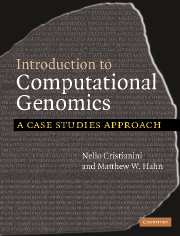Book contents
- Frontmatter
- Contents
- Preface
- Prologue: In praise of cells
- Chapter 1 The first look at a genome
- Chapter 2 All the sequence's men
- Chapter 3 All in the family
- Chapter 4 The boulevard of broken genes
- Chapter 5 Are Neanderthals among us?
- Chapter 6 Fighting HIV
- Chapter 7 SARS – a post-genomic epidemic
- Chapter 8 Welcome to the hotel Chlamydia
- Chapter 9 The genomics of wine-making
- Chapter 10 A bed-time story
- Bibliography
- Index
Chapter 4 - The boulevard of broken genes
Hidden Markov models
Published online by Cambridge University Press: 05 June 2012
- Frontmatter
- Contents
- Preface
- Prologue: In praise of cells
- Chapter 1 The first look at a genome
- Chapter 2 All the sequence's men
- Chapter 3 All in the family
- Chapter 4 The boulevard of broken genes
- Chapter 5 Are Neanderthals among us?
- Chapter 6 Fighting HIV
- Chapter 7 SARS – a post-genomic epidemic
- Chapter 8 Welcome to the hotel Chlamydia
- Chapter 9 The genomics of wine-making
- Chapter 10 A bed-time story
- Bibliography
- Index
Summary
The nose knows
The Nobel Prize in Physiology or Medicine in 2004 went to Richard Axel of Columbia University and Linda Buck of the Fred Hutchinson Cancer Research Center for their elucidation of the olfactory system. The olfactory system is responsible for our sense of smell: it includes a large family of proteins called odorant receptors that in combination make it possible to recognize over 10,000 different odors. These odorant receptors are attached to the surface of cells in our nasal passage, detecting odorant molecules as they are inhaled and passing the information along to the brain.
Gene families
Hidden Markov models
Sequence segmentation
Multiple alignment
In order for odorant receptors (ORs) to both sense molecules outside of the cell and to signal the inside of the cell of their discoveries, these proteins must traverse the cell membrane. To do this, odorant receptors contain seven transmembrane domains: stretches of highly hydrophobic amino acids that interact with the fatty cell membrane. The seven transmembrane domains result in a highly heterogeneous protein sequence: alternating stretches of hydrophobic and hydrophilic amino acids that mark the function of receptor proteins. Axel and Buck's discovery led to the further description of similar receptors involved in the sense of taste and in the detection of pheromones, chemicals used in signaling between organisms.
Information
- Type
- Chapter
- Information
- Introduction to Computational GenomicsA Case Studies Approach, pp. 61 - 77Publisher: Cambridge University PressPrint publication year: 2006
